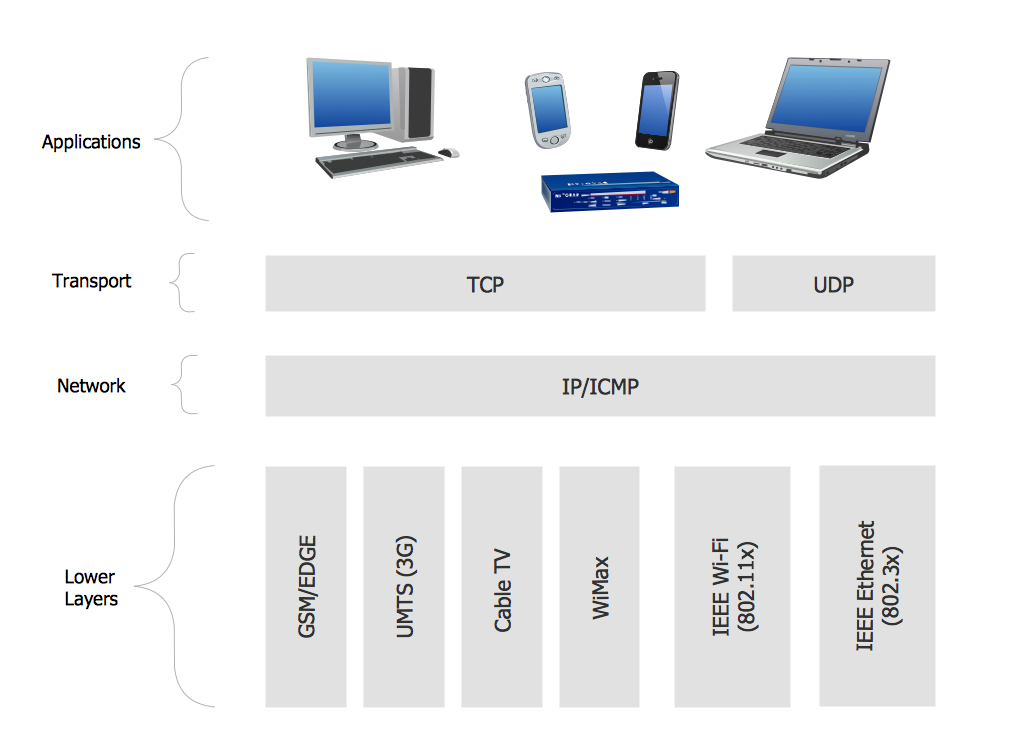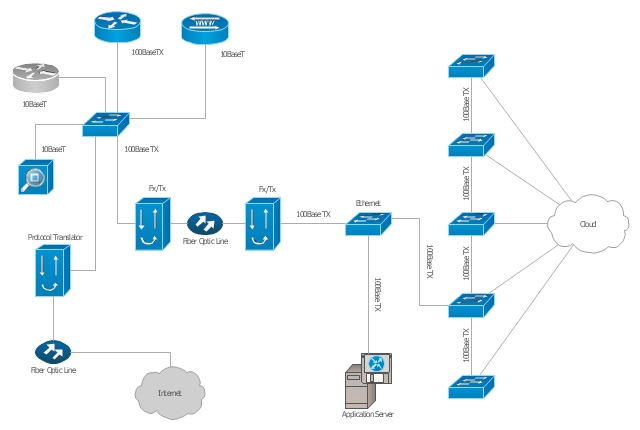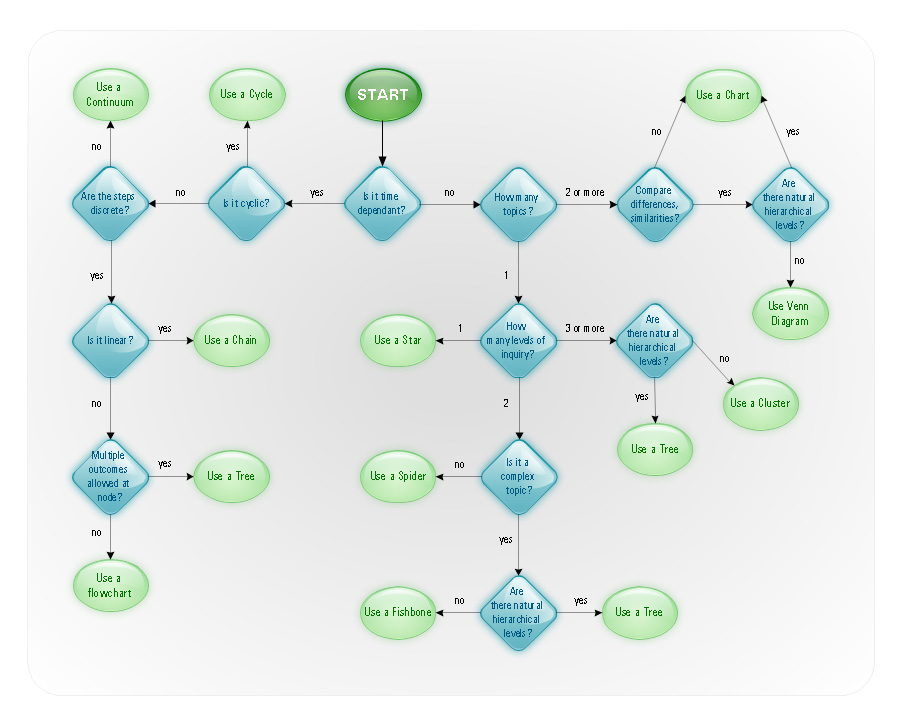"A computer network diagram is a schematic depicting the nodes and connections amongst nodes in a computer network or, more generally, any telecommunications network. ...
Depending on whether the diagram is intended for formal or informal use, certain details may be lacking and must be determined from context. ...
At different scales diagrams may represent various levels of network granularity. At the LAN level, individual nodes may represent individual physical devices, such as hubs or file servers, while at the WAN level, individual nodes may represent entire cities. In addition, when the scope of a diagram crosses the common LAN/ MAN/ WAN boundaries, representative hypothetical devices may be depicted instead of showing all actually existing nodes." [Computer network diagram. Wikipedia]
The Cisco computer network diagram example "Network organization chart" was created using the ConceptDraw PRO diagramming and vector drawing software extended with the Cisco Network Diagrams solution from the Computer and Networks area of ConceptDraw Solution Park.
Depending on whether the diagram is intended for formal or informal use, certain details may be lacking and must be determined from context. ...
At different scales diagrams may represent various levels of network granularity. At the LAN level, individual nodes may represent individual physical devices, such as hubs or file servers, while at the WAN level, individual nodes may represent entire cities. In addition, when the scope of a diagram crosses the common LAN/ MAN/ WAN boundaries, representative hypothetical devices may be depicted instead of showing all actually existing nodes." [Computer network diagram. Wikipedia]
The Cisco computer network diagram example "Network organization chart" was created using the ConceptDraw PRO diagramming and vector drawing software extended with the Cisco Network Diagrams solution from the Computer and Networks area of ConceptDraw Solution Park.
Control and Information Architecture Diagrams (CIAD) with ConceptDraw PRO
One of the three main constituents of any enterprise is the Control and Information Architecture. The rest two are Production facilities and People and Organization."Zooko's triangle is a diagram named after Zooko Wilcox-O'Hearn which sets out suspected tradeoffs for a system for giving names to participants in a network protocol. At the vertices of the triangle are three properties that are generally considered desirable for such names:
Secure: The quality that there is one, unique and specific entity to which the name maps. For instance, domain names are unique because there is just one party able to prove that they are the owner of each domain name.
Decentralized: The lack of a centralized authority for determining the meaning of a name. Instead, measures such as a Web of trust are used.
Human-meaningful: The quality of meaningfulness and memorability to the users of the naming system. Domain names and nicknaming are naming systems that are highly memorable." [Zooko's triangle. Wikipedia]
This triangle diagram sample was redesigned using the ConceptDraw PRO diagramming and vector drawing software from Wikimedia Commons file Zooko%27s_ Triangle.svg. [commons.wikimedia.org/ wiki/ File:Zooko%27s_ Triangle.svg]
The triangular chart example "Zooko's triangle diagram" is included in the Pyramid Diagrams solution from the Marketing area of ConceptDraw Solution Park.
Secure: The quality that there is one, unique and specific entity to which the name maps. For instance, domain names are unique because there is just one party able to prove that they are the owner of each domain name.
Decentralized: The lack of a centralized authority for determining the meaning of a name. Instead, measures such as a Web of trust are used.
Human-meaningful: The quality of meaningfulness and memorability to the users of the naming system. Domain names and nicknaming are naming systems that are highly memorable." [Zooko's triangle. Wikipedia]
This triangle diagram sample was redesigned using the ConceptDraw PRO diagramming and vector drawing software from Wikimedia Commons file Zooko%27s_ Triangle.svg. [commons.wikimedia.org/ wiki/ File:Zooko%27s_ Triangle.svg]
The triangular chart example "Zooko's triangle diagram" is included in the Pyramid Diagrams solution from the Marketing area of ConceptDraw Solution Park.
This infographic sample visualizes the Conventional and wireless ad hoc network. It was designed on the base of the Wikimedia Commons file: Běžná bezdrátová síť a ad hoc síť.png.
[commons.wikimedia.org/ wiki/ File:B%C4%9B%C5%BEn%C3%A1_ bezdr%C3%A1tov%C3%A1_ s%C3%AD%C5%A5_ a_ ad_ hoc_ s%C3%AD%C5%A5.png]
This file is licensed under the Creative Commons Attribution-Share Alike 4.0 International license. [creativecommons.org/ licenses/ by-sa/ 4.0/ deed.en]
"A wireless ad hoc network (WANET) is a decentralized type of wireless network. The network is ad hoc because it does not rely on a pre existing infrastructure, such as routers in wired networks or access points in managed (infrastructure) wireless networks. Instead, each node participates in routing by forwarding data for other nodes, so the determination of which nodes forward data is made dynamically on the basis of network connectivity. In addition to the classic routing, ad hoc networks can use flooding for forwarding data.
Wireless mobile ad hoc networks are self-configuring, dynamic networks in which nodes are free to move. Wireless networks lack the complexities of infrastructure setup and administration, enabling devices to create and join networks "on the fly" – anywhere, anytime." [Wireless ad hoc network. Wikipedia]
The infographic example "Conventional and wireless ad hoc network" was created using the ConceptDraw PRO diagramming and vector drawing software extended with the Computers and Communications solution from the Illustration area of ConceptDraw Solution Park.
[commons.wikimedia.org/ wiki/ File:B%C4%9B%C5%BEn%C3%A1_ bezdr%C3%A1tov%C3%A1_ s%C3%AD%C5%A5_ a_ ad_ hoc_ s%C3%AD%C5%A5.png]
This file is licensed under the Creative Commons Attribution-Share Alike 4.0 International license. [creativecommons.org/ licenses/ by-sa/ 4.0/ deed.en]
"A wireless ad hoc network (WANET) is a decentralized type of wireless network. The network is ad hoc because it does not rely on a pre existing infrastructure, such as routers in wired networks or access points in managed (infrastructure) wireless networks. Instead, each node participates in routing by forwarding data for other nodes, so the determination of which nodes forward data is made dynamically on the basis of network connectivity. In addition to the classic routing, ad hoc networks can use flooding for forwarding data.
Wireless mobile ad hoc networks are self-configuring, dynamic networks in which nodes are free to move. Wireless networks lack the complexities of infrastructure setup and administration, enabling devices to create and join networks "on the fly" – anywhere, anytime." [Wireless ad hoc network. Wikipedia]
The infographic example "Conventional and wireless ad hoc network" was created using the ConceptDraw PRO diagramming and vector drawing software extended with the Computers and Communications solution from the Illustration area of ConceptDraw Solution Park.
- Network Diagram Examples | Network Protocols | Network Diagram ...
- Network Protocols | Active Directory diagrams with ConceptDraw ...
- Network Diagram Examples | Network Protocols | Wireless Network ...
- Network Diagram Software LAN Diagrams | Basic Network Diagram ...
- Network Diagram Examples | ConceptDraw PRO Network Diagram ...
- Network Protocols | Active Directory diagrams with ConceptDraw PRO
- Network Diagram Examples | Network Architecture | Network ...
- Network Diagram Software Logical Network ... - Conceptdraw.com
- Basic Network Diagram | Network Diagram Software LAN Diagrams ...
- Network Diagram Examples | Hotel Network Topology Diagram ...
- Active Directory diagrams with ConceptDraw PRO | Network ...
- Network Diagram Software Home Area Network
- ConceptDraw PRO Network Diagram Tool | Computer and Networks ...
- Network Diagram Examples | Network Architecture | Network ...
- Cisco Network Topology | Network Diagramming Software for ...
- Network Topology | Basic Network Diagram | Network Diagram ...
- Network Diagram Examples | Network Diagram Software | Network ...
- Network Diagram Software LAN Diagrams - Conceptdraw.com
- How to Draw a Computer Network Diagrams | Computer and ...
- Basic Network Diagram | Computer and Networks Area | Network ...





